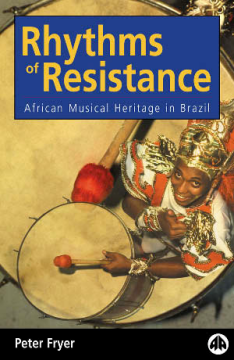
Additional Information
Book Details
Abstract
African rhythms are at the heart of contemporary black Brazilian music. Surveying a musical legacy that encompasses over 400 years, Rhythms of Resistance traces the development of this rich cultural heritage.
Acclaimed author Peter Fryer describes how slaves, mariners and merchants brought African music from Angola and the ports of East Africa to Latin America. In particular, they brought it to Brazil – today the country with the largest black population of any outside Africa. Fryer examines how the rhythms and beats of Africa were combined with European popular music to create a unique sound and dance tradition. Fryer focuses on the political nature of this musical crossover and the role of an African heritage in the cultural identity of Brazilian blacks today.
Rhythms of Resistance is an absorbing account of a theme in global music and is rich in fascinating historical detail.
'Peter Fryer has now taken the study of the history of Brazilian music to another level'
Journal of Iberian and Latin American Studies
Table of Contents
| Section Title | Page | Action | Price |
|---|---|---|---|
| Contents | vii | ||
| List of Maps | viii | ||
| List of Fgures | ix | ||
| Preface | xiii | ||
| Introduction | 1 | ||
| Challenge singing and the Atlantic cultural triangle | 1 | ||
| The African presence in Brazil | 5 | ||
| The African cultural heritage in Brazil | 8 | ||
| 'Neo- African' music in Brazil | 9 | ||
| The sources of Brazil's 'neo-African' music | 11 | ||
| 1. The Heritage of Nigeria and Benin: Music for Worship | 13 | ||
| African- derived religions in Brazil | 13 | ||
| African- Brazilian religious music | 18 | ||
| Candomblé and carnival | 23 | ||
| 2. The Angolan Heritage: Capoeira and Berimbau | 27 | ||
| Training for resistance | 27 | ||
| African prototypes of the berimbau | 32 | ||
| The berimbau in Brazil | 35 | ||
| 3. The 'Angola Warble': Street Cries and Worksongs | 40 | ||
| The cities | 40 | ||
| The countryside | 50 | ||
| The songs of the miners | 52 | ||
| 4. Brazil's Dramatic Dances | 55 | ||
| Lay brotherhoods and danced processions | 55 | ||
| Coronation ceremonies | 61 | ||
| Palmares and the Quilombo | 68 | ||
| The Moçambique | 73 | ||
| Bumba-meu-boi and the power of satire | 74 | ||
| Cambinda : a festival of liberation | 77 | ||
| 5. Three Vanished Instruments | 78 | ||
| The lamellophone ( marimba) | 78 | ||
| The pluriarc ( compound bow- lute) | 83 | ||
| The xylophone ( marimba) | 84 | ||
| 6. The African Dance Heritage | 86 | ||
| African dance in Brazil | 86 | ||
| Batuque and the rural samba | 95 | ||
| Samba: the word | 102 | ||
| Jongo and caxambu | 104 | ||
| The coco | 106 | ||
| The calango | 107 | ||
| 7. Brazil's Atlantic Dances | 109 | ||
| The Atlantic dance tradition | 109 | ||
| The lundu: Brazil's first national dance | 116 | ||
| The fofa that came from Bahia | 126 | ||
| The fado in Brazil | 128 | ||
| 8. The Emergence of Brazilian Popular Music | 134 | ||
| Brazil's slave orchestras | 134 | ||
| How Brazilian popular music arose | 137 | ||
| The modinha and the sung lundu | 142 | ||
| The African heritage in Brazilian popular music | 147 | ||
| 9. Maxixe and Modern Samba | 154 | ||
| Appendix A. Continuity and Change in the Music of the Kongo- Angola Culture Area | 158 | ||
| Appendix B. African Musical Instruments in Brazil | 161 | ||
| Appendix C. The Brazilian Musical Heritage in Nigeria and Benin | 170 | ||
| Appendix D. The Music and Dance of Cape Verde | 173 | ||
| Appendix E. Relacao da fofa que veya agora da Bahia: Extract | 176 | ||
| Description | 176 | ||
| Extract | 176 | ||
| Discography | 178 | ||
| Brazil | 178 | ||
| Africa ( including Cape Verde) | 186 | ||
| Other areas | 189 | ||
| Notes | 191 | ||
| Introduction | 191 | ||
| Chapter 1 | 199 | ||
| Chapter 2 | 204 | ||
| Chapter 3 | 209 | ||
| Chapter 5 | 218 | ||
| Chapter 6 | 220 | ||
| Chapter 7 | 224 | ||
| Chapter 8 | 231 | ||
| Chapter 9 | 237 | ||
| Appendix A | 238 | ||
| Appendix B | 238 | ||
| Appendix C | 240 | ||
| Appendix D | 241 | ||
| Discography | 242 | ||
| Index | 243 | ||
| Abel, Clarke 79 | 79 | ||
| Abel, Clarke, | 6 |
